Welcome to the Yodo1 Blog
Bringing you the latest news and updates from Yodo1, the mobile gaming industry, and work-from-anywhere culture
Game Growth
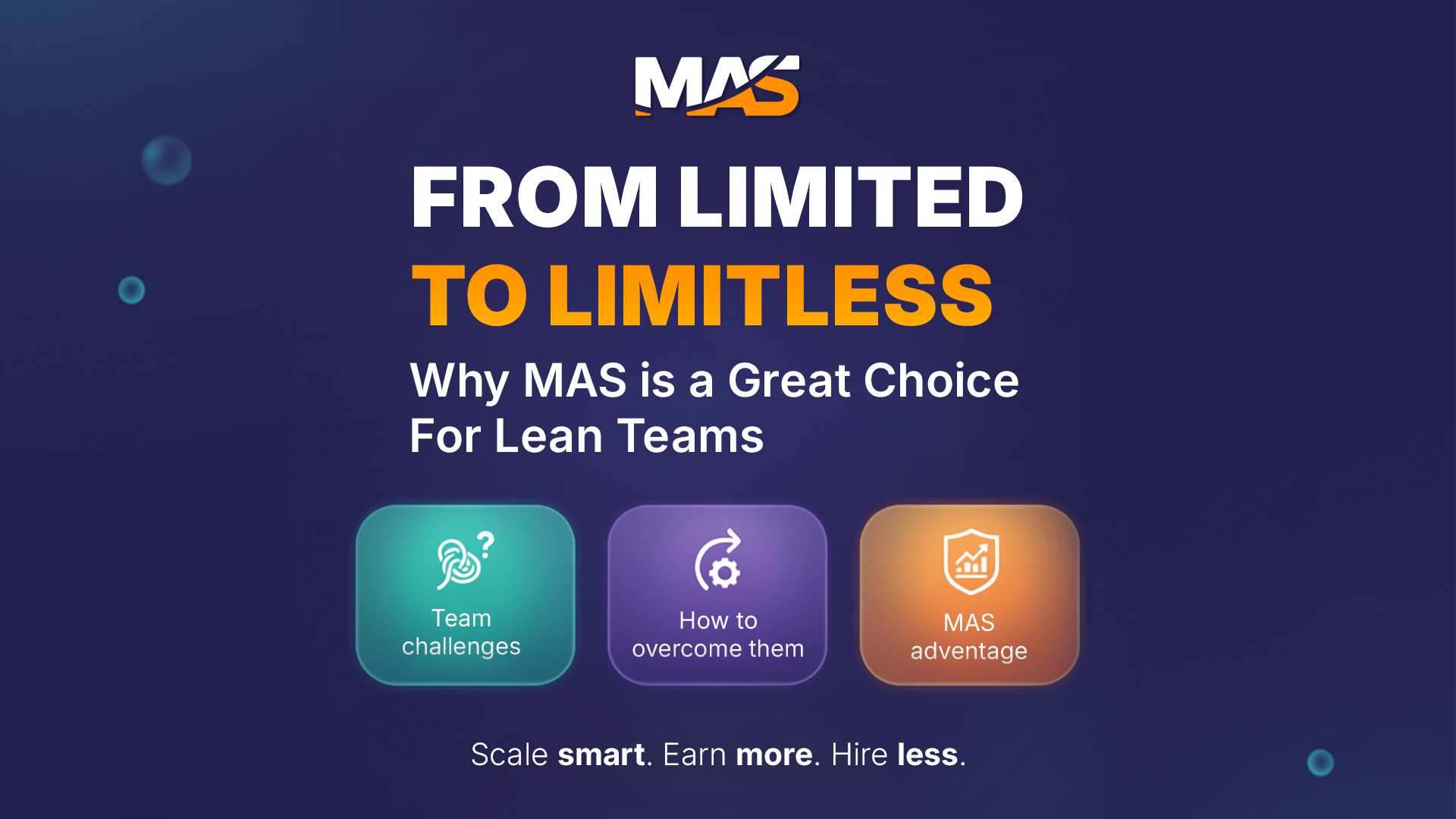
From Limited To Limitless: Why MAS Is A Great Choice For Lean Teams
26.11.2025
•
5 mins read
The mobile apps market is booming, with mobile games making up over half of the indie segment and projected to grow at 17% CAGR through 2030. On the surface, it looks like a golden opportunity. But for small studios, turning that growth into actual revenue isn’t as simple as it seems.
The Everyday Challenges of Lean Teams
Competing on crowded app stores, paying ever-rising UA costs, and trying to grow alongside AAA players with large marketing budgets is already a stretch of resources. And for lean teams, it’s also piling up with internal challenge:
- No room in the budget for specialists. With revenue unstable, there’s no budget for ad ops managers, so monetization falls on already busy developers.
- Limited time resources. Every hour spent testing networks or adjusting waterfalls is time taken away from building the game itself.
- Mistakes are costly. Compliance issues, wrong setups, or bad reporting don’t just take time to fix — they cut directly into revenue.
So, for small teams, the challenge isn’t just growth — it’s achieving it with limited time and money.
MAS Can Save The Day
MAS by Yodo1 is a monetization solution that connects your game to top ad networks and optimizes performance through a mix of AI and expert support. It takes care of waterfalls, bidding, ANRs and network testing — saving lean teams both time and money while reducing the risk of costly mistakes.
How MAS Meets the Needs of Small Teams
MAS is built to support lean teams with their everyday challenges, so you can stay focused on game development:
- Removes the need for additional hires by taking on the work of ad ops specialists.
- Saves developers’ time through automated mediation and testing.
- Keeps budgets on track with compliance, smooth integrations, and accurate reporting.
Externally, MAS helps teams:
- Compete in crowded marketplaces by maximizing revenue from existing players instead of relying solely on UA.
- Offset rising UA costs by boosting ad efficiency and creating budget headroom to reinvest in growth.
- Levels the playing field with professional-grade monetization at a fraction of enterprise-level costs, helping smaller teams grow sustainably even in AAA-dominated markets.
Real Teams, Real Results
We’ve seen the benefits of MAS monetization optimisation across both gaming and non-gaming apps:
- Kenpasoft (Brasileiro Apps): Before MAS, the team experienced low ROAS and was operating with a limited mediation setup, using only one ad network. After integration, ARPDAU grew by 59% in just one week, while eCPM nearly doubled. More insights are available in the full case study.
- ActFirst Games: Recently, we worked with ActFirst Games, the studio behind the hit Obsidian Knights, which wanted to explore if there were untapped ad revenue opportunities. After the full MAS integration, ARPDAU increased by 48%, revealing significant monetization potential. Learn more in the case study.
Ready To Boost Your Revenue?
For lean teams, every resource counts. MAS automates mediation to drive faster ad revenue growth, while your team stays focused on making great games.
Ready to improve your monetisation strategy results?
Game Growth
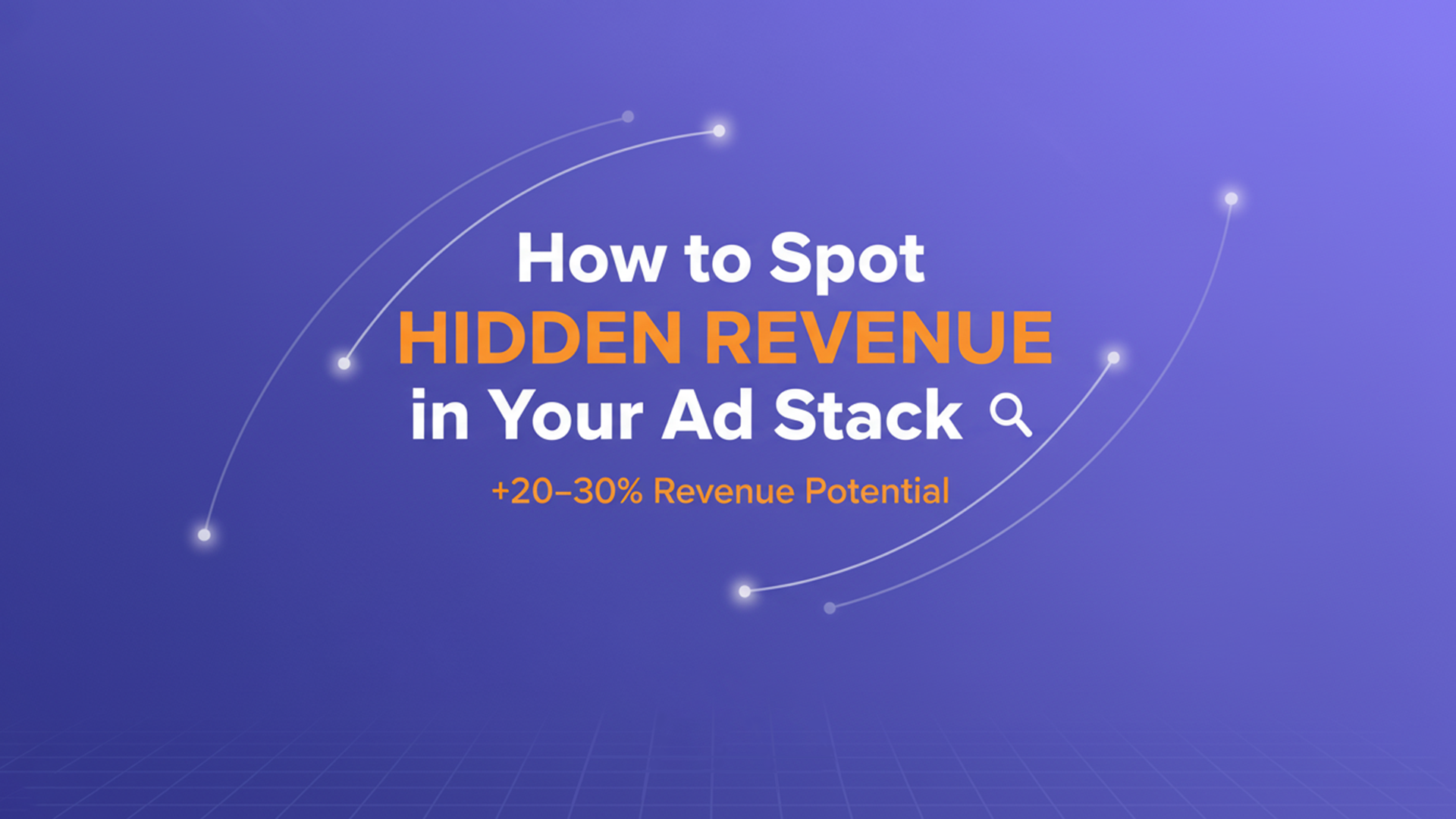
How to Spot Hidden Revenue in Your Ad Stack
11.11.2025
•
5 mins read
Every year, mobile games leave millions of dollars on the table — not because their titles lack players, but because their ad stacks aren’t optimized. According to industry estimates, poorly structured mediation and outdated SDKs can reduce ad revenue by 20–30%, meaning that for a game generating $1M annually from ads, up to $300,000 could be lost without developers even noticing.
Why is this revenue hidden?
There’re few common reasons from the technical side:
- Fragmented mediation setup: Many developers rely on a single network or outdated waterfalls, leaving demand sources untapped.
- Lack of transparency: Without proper reporting, it’s hard to know which ad units underperform.
- Unbalanced ad strategy: Too many interstitials can hurt retention, while too few rewarded ads miss monetization opportunities.
- Slow SDK updates: Networks release optimizations regularly, so it’s essential to update your SDKs to avoid draining eCPMs. Heavy SDKs can also slow performance, frustrating players and causing churn.
And a few more from the development team side:
- Hard to keep up with ever-changing ad tech (SDK versions, bidding adoption).
- Limited time or expertise to A/B test ad placements.
- Difficulty analyzing regional performance — what works in the US may flop in Brazil.
- Fear of hurting player experience when experimenting with new formats.
How to capture hidden revenue with MAS?
That’s where MAS (Managed Ad Services) comes in. MAS connects your game to multiple ad networks through one SDK and automatically optimizes placements, formats, and bidding for more effective revenue effect.
More precisely, here’s how MAS helps developers spot and capture hidden revenue:
- Full mediation coverage: Full mediation coverage: MAS integrates and manages multiple top ad networks—and keeps adding new ones—so you never miss demand from the highest bidder.
- Always up-to-date SDKs: The MAS team handles all updates, so your game runs on the latest optimizations without dev headaches.
- Smart ad strategy: MAS places and balances ad formats to boost ARPDAU while maintaining retention, turning rewarded ads into both revenue and engagement drivers.
- Global performance insights: With MAS, you can compare monetization across regions and adapt strategy for every market.
- Hands-off growth partner: MAS continuously audits, tests, and adjusts your ad stack, so you’re not leaving 20–30% of potential revenue on the table.
Win This Hide and Seek
Getting the most from your ad stack means more than just chasing higher eCPMs — it’s about keeping monetization smooth without burning developer time. Having experienced these challenges firsthand as a publisher, we built MAS to take care of the complex parts in the background and make our insights available to everyone, so you can focus on making great games.
IP Licensing

From Fear to Pride: What October’s Gaming Collabs Teach Us About IP Strategy
04.11.2025
•
5 mins read
Look back on IP Collabs during October | Powered by IPverse
Players are not just chasing brands. They are chasing feelings. Fear in the dark with friends. Pride in a story that feels like home. The studios that win are building an IP operating system—one that turns collaborations into sustained growth, not one-off fireworks.
The IPverse Framework: World, Moment, Mechanic
Use this three-lens test before you sign any collaboration.
- World: Does the partner IP extend or enrich your game’s fantasy rather than sit on top of it?
- Moment: Is there a cultural or calendar moment that naturally amplifies discovery and earned media?
- Mechanic: What new behaviour will this IP unlock in your LiveOps or economy that persists after the campaign?
If you cannot answer all three with specifics, you do not have a collaboration. You have a poster.
Case Reads and What to Steal

Fortnite × Scream (Ghostface)
Fortnitemares 2025 brings transformation mechanics that move beyond a skin. That matters. Cosmetics lift ARPDAU for days. Mechanics shift cohorts.
Yodo1’s take: Build IPs that change how players behave. A seasonal fear theme is the excuse—the real win is repeatable design space.
What to steal:
- Tie a limited transformation to a social trigger such as proximity voice or squad downs.
- Run a creator challenge rewarding creative kills or stealth routes—the content loop is the marketing.
- Keep one mechanic fragment as a permanent unlock to create post-event stickiness.

Honor of Kings × Sanxingdui
Four limited skins inspired by archaeological bronzework for the 10th anniversary. This is not heritage as wallpaper. It is heritage as meaning.
Yodo1’s take: Cultural authenticity builds trust and frequency. It also clears regulatory review with ease.
What to steal:
- Co-create with museum partners so the visual language and lore are precise.
- Design progression that teaches without preaching—drip lore through quest breadcrumbs and AR filters outside the game.
- Treat heritage IP as a long arc. Return to it annually with new chapters rather than a one-off celebration.
.jpg)
Azur Lane × DanMachi V
Anime fandom meets gacha discipline. New story missions and limited ships are almost too easy, yet they work because both communities are mobilised.
Yodo1’s take: Anime crossovers are mature territory. Differentiation now comes from narrative cadence and pity-system tuning, not just the guest star.
What to steal:
- Build a three-beat narrative arc that escalates daily, not over weeks.
- Make shard acquisition routes legible—confusion kills spend in time-boxed events.
- Commission two influencer micro-series in parallel: one lore-focused, one gameplay meta.

Magic: The Gathering × Jaws
Secret Lair turns nostalgia into a recurring revenue machine. Small drops, sharp art direction, confident curation.
Yodo1’s take: Micro-drops are the ultimate IP sandbox. You test appetite without retooling the core game.
What to steal:
- Pilot micro-drops around film anniversaries and soundtrack remasters.
- Offer a collector path and a player path. The art variant is a trophy; the rules variant is the meta.
- Use scarcity honestly—short windows, transparent print numbers, zero false FOMO.
Market Signals to Watch
- Q4 horror beats Q4 cosy in share velocity across social and creator platforms, especially for ages 13–24.
- Heritage collaborations in China sustain longer DAU tails because they live inside cultural conversation, not just game news.
- Cross-platform synchronisation now defines reach: if cosmetics and entitlements aren’t portable, you pay twice to win once.
Deal Mechanics That Maximise Upside
- Licence for the system, not a skin. Secure rights to reuse motifs, SFX stems, VO lines, and UI widgets in future events.
- Bundle the moment. Lock in promotional beats on partner channels, plus music rights for short-form edits and creator remixes.
- Own your metrics. If you cannot tag partner posts and track inbound traffic, your incrementality study will be folklore.
Measurement That Actually Proves Value
Don’t stop at immediate revenue—prove you changed trajectory.
- Leading indicators: Day-zero and day-three install lift versus control geos, creator clip velocity, wishlist adds for upcoming modes.
- Cohort shift: 30- and 60-day reactivation from lapsed players who engaged with the collaboration.
- Economy health: Spend distribution across price tiers to confirm you didn’t over-skew whales.
- Cultural footprint: Share of voice inside the partner IP’s community, not just your own.
Risks to Manage
- Aesthetic mismatch: Gorgeous art that breaks your UI readability will tank ranked modes.
- Regulatory drift: Heritage IPs need provenance and disclaimers integrated early.
- Over-rotation: Too many back-to-back collaborations train players to wait for the next one—space them strategically.
The 12-Month IP Calendar Playbook
Think in seasons and families, not single hits.
- Q1: Identity & tech — sci-fi, mechs, gadgets; aligned with esports cycles.
- Q2: Adventure & travel — outdoor brands, film tourism boards, social referral loops.
- Q3: Music & fashion — festival capsules and avatar expression; prime UGC window.
- Q4: Fear & legacy — horror, heritage, and awards season; double down on narrative and micro-drops.
Where BiG and IPverse Help
We treat IP as a system. IPverse identifies high-fit partnerships through data on audience overlap, cultural moments, and mechanic feasibility. BiG negotiates the deal terms that secure reuse rights, data visibility, and promotional muscle—then helps your team ship the live ops that make it profitable.
Closing Thought
Master the World, Moment, Mechanic framework, and every collaboration becomes more than a campaign—it becomes part of your game’s DNA. To translate any of the above into a live plan, we can map partner shortlists, calendar slots, mechanic concepts, and measurement blueprints in one working session.
Want to learn more about making the most of IP's in your game?
IP Licensing

From Subway Runs to Haunted Manors: September’s Biggest IP Crossovers
15.10.2025
•
5 mins read
Powered by IPverse • Published by Yodo1
Every month, we pull signal from noise: the most impactful IP crossovers, market shifts you shouldn’t miss, notable releases, and what it all means for studios planning their next move. (Powered by IPverse, Yodo1’s AI-assisted IP licensing and insights platform.) This months spotlights a new bar for reciprocal collabs, the continued gravitational pull of anime IP, and the business power of nostalgia.
Yodo1 Corner
From our team to yours—what we’re seeing and how to act on it:
- Reciprocal Collabs = Multipliers, Not Add-ons. We’re advising partners to design two-way integrations with mirrored value: content and mechanics in both titles, shared LiveOps calendars, and coordinated creator campaigns. This is how you convert “cool moment” into durable LTV lift.
- Anime Still Prints Money—If You Localize the Emotion. The best-performing runs pair faithful character kits with contextual event beats (voice lines, story snippets, region-specific challenges) rather than a generic reskin.
- Nostalgia With New Toys. Anniversary and retro revivals work best when they bundle QoL updates, modern monetization paths, and a light skill curve so lapsed fans feel powerful by Day 2.
Want a second set of eyes on your collab pitch or P&L? Send us your goals and we’ll map the fastest route—IP sourcing, deal terms, creative, LiveOps, and measurement—end-to-end.
Top IP Collaborations
Brawl Stars × Subway Surfers — Reciprocal Crossover

Global (Mobile) • Sep 4–Oct 5, 2025
What happened: Two juggernauts trade deep content. Subway Surfers introduces six Brawl Stars characters and a “Showdown” mode; Brawl Stars ships a “Subway Run” mode plus themed skins—a true two-way experience rather than one IP guesting in another.
Why it matters: This is the template for 2025–26: parity of effort, fresh mode design, and co-owned outcomes (UA, retention, and revenue) across both ecosystems.
Yodo1’s take:
- Design for Habit, Not Hype. Bake the crossover into your daily loop (quests, streaks, limited gear paths) so it powers D2/D7 habit formation, not just Day-0 installs.
- Mirror the Mechanics. If you’re the faster-twitch title, import traversal verbs from your partner; if you’re the runner, borrow combat cadence—give players a new rhythm to master.
- Shared KPI Contract. Define mutual targets (cross-game MAU migration, ARPDAU by cohort, sink utilization) and split incentives that reward both sides for long-tail performance.
- Creator Co-Launch. Synchronize challenges (speedrun + high-score + build meta) across both titles with the same hashtag to compound reach and reduce CAC.
PUBG MOBILE × Resident Evil

Global (Mobile) • Starting Sep 4, 2025
What happened: Jill Valentine and Ada Wong drop with Version 4.0, plus ghost-themed mechanics, an asymmetric PvP mode (“Unfail”), and a Haunted Manor POI—survival horror meets BR.
Why it matters: Seasonal horror + BR sandbox = repeatable tentpole. Asymmetric modes drive UGC, clip-worthy moments, and re-engagement without fracturing your core loop.
Yodo1’s take:
- Ship a ‘Fear Funnel’. Calibrate difficulty bands (casual scares → high-stress hunts) that ladder players into the asymmetric mode—don’t strand the new audience behind high MMR walls.
- Inventory With Intention. Limited horror cosmetics should have use value (e.g., event perks, aura interactions) to avoid pure vanity fatigue.
- Regional Cadence. Lean into spooky season timing differentials (LATAM vs. APAC) with rolling mini-beats to keep CPM efficient and organics steady.
- Measure the Right Thing. Track mode elasticity (how many players return to core BR after horror sessions) to prove additive value, not cannibalization.
War of the Visions: FFBE × Valkyrie Profile: Lenneth
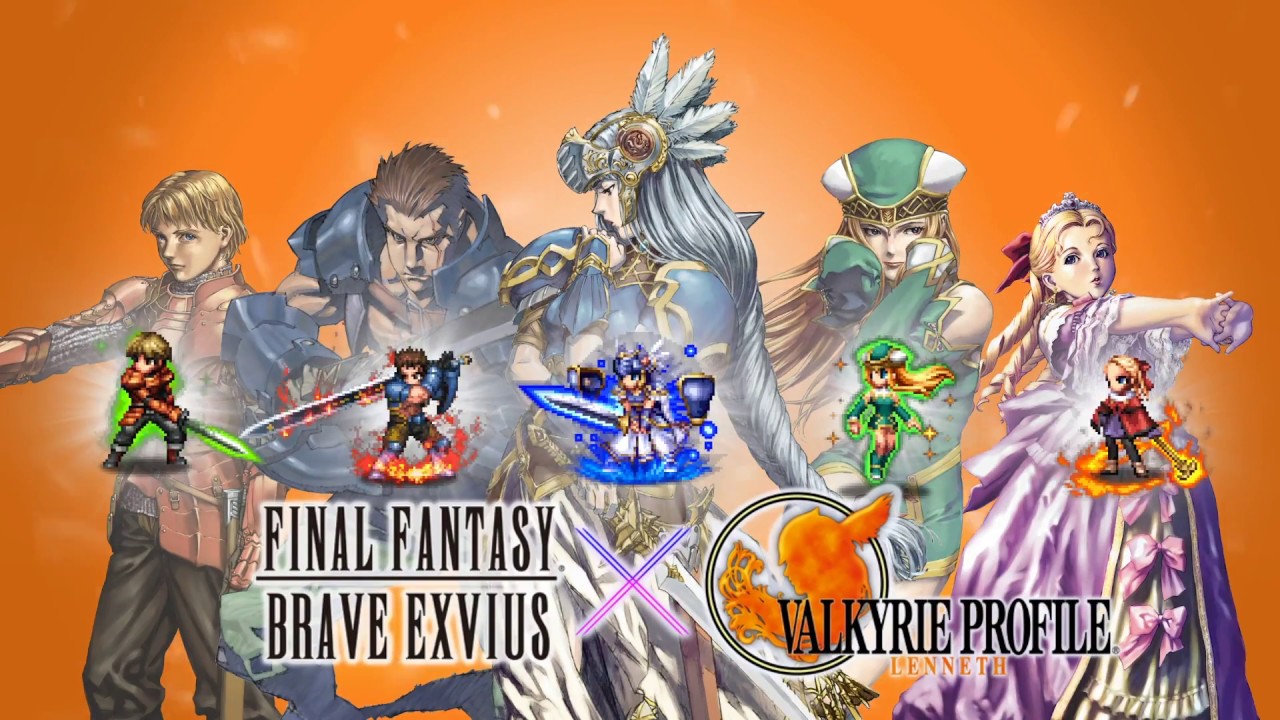
Japan (Mobile) • Sep 1–Oct 16, 2025
What happened: Lenneth, Arngrim, and Freya arrive with themed vision cards, quests, and login bonuses—celebrating Valkyrie Profile’s 25th.
Why it matters: JP market nostalgia remains a top ARPU driver if you respect canonical kits and music cues, and protect the power curve for existing whales.
Yodo1’s take:
- Anniversary Architecture. Pair the banner with a rerun lane and an entry lane: vets chase perfect rolls; returners get curated catch-up packs to reach competitive thresholds in 48–72 hours.
- Whale-Safe Design. Avoid stat bloat; introduce situational dominance (e.g., boss counters) to keep meta interesting without invalidating legacy spend.
- Merch & Media Sync. Cross with OST drops, art-books, or creator retrospectives—nostalgia is a multimedia prompt, not just a banner.
Arknights × Delicious in Dungeon (Phase 2)
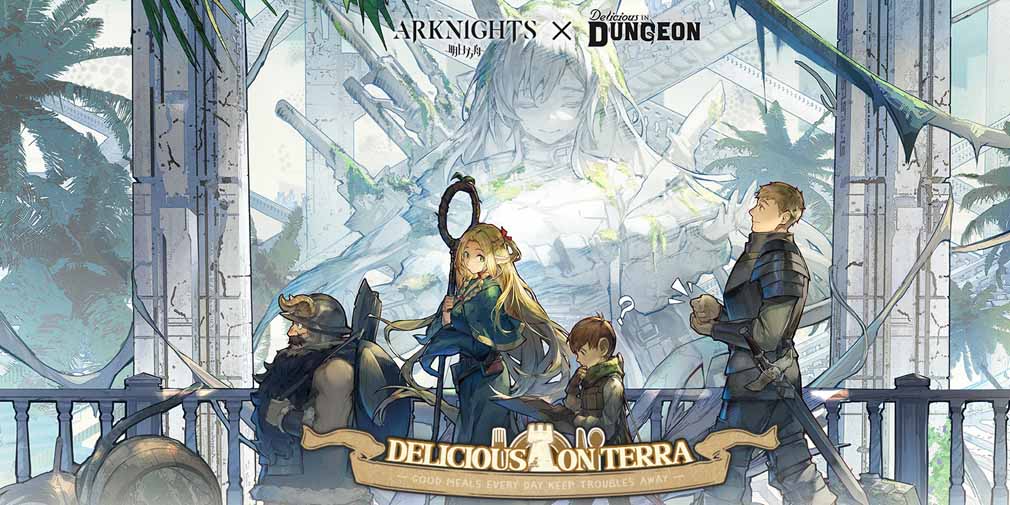
Global (Mobile) • Sep 2–Sep 23, 2025
What happened: New operator Izutsumi (5★ Specialist) debuts alongside limited “Vector Breakthrough” stages that combine ingredient crafting and environmental manipulation—bridging the anime’s cooking/dungeon themes with Arknights’ tactical DNA.
Why it matters: It’s a masterclass in mechanic-level IP fusion: not just a skin, but a new way to think about stage solutions.
Yodo1’s take:
- Mechanics, not Mascots. When the source IP has a strong verb (cook, sneak, unravel), bring that verb into your puzzle space. That’s what drives stickiness and rave reviews.
- Event On-Ramp. Provide a low-stress discovery path (story stages, “practice” tiles) so anime fans can enjoy the fantasy without slamming into high-APM walls.
- Post-Event Harvest. Migrate the best mechanics into a permanent roguelite node; let latecomers taste the magic while you rerun the monetization beat later.
Market Insights (and How to Use Them)
1) Reciprocal Crossovers Are the New Standard
The Subway Surfers × Brawl Stars play shows the market moving past “guest cameo” into co-created experiences. Expect players to compare your collab to the best they’ve seen.
Yodo1 guidance:
- Scope two mode hooks, one for each game.
- Share art pipelines early to avoid bottlenecks (shader parity, rigging constraints).
- Create a joint retention plan: alternating micro-beats that pass the baton week-to-week.
2) Anime IP Dominance, Still
Bleach, FMA, Jujutsu Kaisen—the pattern holds: passionate core audiences respond to authenticity, voice work, and lore-aware challenges.
Yodo1 guidance:
- Prioritize VO & story moments over sheer banner volume.
- Use region-specific challenges (kanji puzzles, spirit mechanics) where culturally appropriate.
- Budget for community collabs (fan artists, cosplayers) to turn your event into culture, not just content.
3) Nostalgia-Fueled Releases
From Valkyrie Profile celebrations to retro-style newcomers, emotional memory is a growth lever—if you modernize the experience.
Yodo1 guidance:
- Offer returning-player ladders (fast catch-up bundles + curated tips).
- Add modern QoL (auto-equip, smarter tutorials) and celebrate mastery with score attacks and time trials.
- Tie nostalgia to limited-time sinks that feel celebratory, not exploitative.
New Releases & Collab Potential
Borderlands 4 (PC/Console) — Sep 12, 2025

New planet (Kairos), upgraded traversal, 4-player co-op.
Yodo1’s take:
- Mobile Tie-ins: Co-branded timed events with loot chest cosmetics, skill-tree “skill shots,” or roguelite runs themed around Vault hunts.
- Partner Fit: Best for shooters, looters, and stylish action titles that can translate quirk + chaos into their core loop.
- What to Pitch: Weapon skin passes with perk ecosystems, streamer bounty boards, and clip-driven challenges.
Silent Hill f (PC/Console) — Sep 25, 2025

1960s Japan setting with psychological horror.
Yodo1’s take:
- Seasonal Anchor: Design your October slate around atmospheric modes, audio stingers, and “fear of the unknown” mechanics.
- Partner Fit: Titles with stealth, fog-of-war, or sanity meters; puzzle and narrative games can craft haunting, low-APM experiences.
- What to Pitch: Limited “whisper” cosmetics, diegetic UI glitches, audio lore collectibles.
Plants vs. Zombies 3 (China, Mobile) — Sep 26, 2025
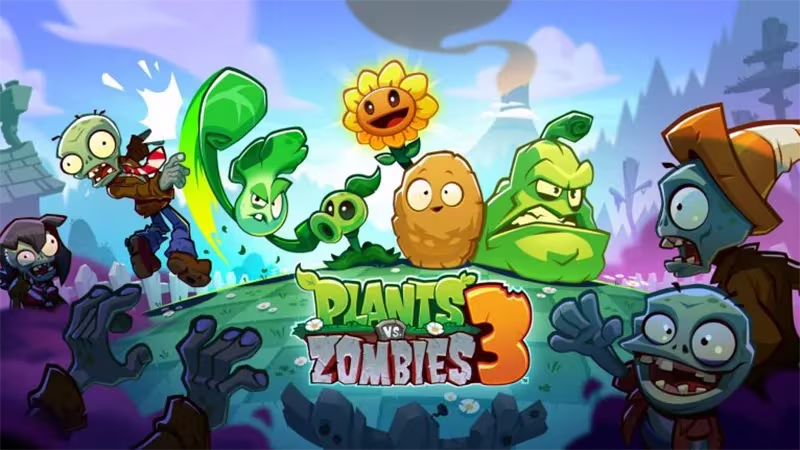
Element evolution and localized content aim to re-ignite a massive audience.
Yodo1’s take:
- CN-First Reality: Tune level ramps for short mobile sessions; front-load clarity, then depth.
- Partner Fit: Casual-midcore tower defense, merge, and builder games seeking broad four-quadrant appeal.
- What to Pitch: Festive holiday beats, brand tie-ins, and snackable challenges; maximize social graph reactivation.
How Yodo1 Helps You Win IP Collabs
- IP Sourcing & Fast-Track (LIFT): Shortlist the right IPs, negotiate win-win terms, and move from idea to signed deal without losing a season.
- Creative & LiveOps: From GDDs to playable prototypes, event economies, and calendar orchestration—we make sure the collab plays as good as it looks.
- Monetization Backbone (SABRE): Offers, sinks, and bundles engineered for event cadence and cohort health.
- Measurement That Matters (via IPverse): We align on cross-game KPIs—migration, elastic retention, and event ROI—so both partners see durable value.
Talk to Us
There are many ways to grow a game. The trick is knowing where to start. Whether you’re optimizing monetization or hunting for the IP that will light up your community, we’ll build the plan and run it with you.
Contact Yodo1 for IP Licensing & LiveOps Support.
Tell us your goals—we’ll do the rest.
Game Growth
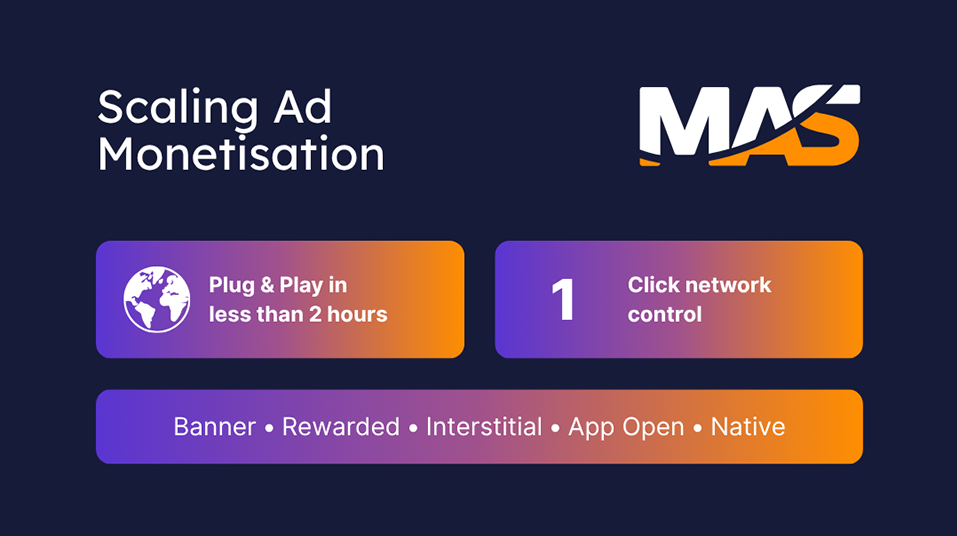
Scaling Ad Monetisation with MAS
13.10.2025
•
5 mins read
Evaluating MAS at scale? Whether you’re testing it internally or looking for a better alternative to your current setup, this FAQ answers the questions large studios ask most — to remove any uncertainty and make your MAS journey smoother.
Integration & Setup
1. Do we need to connect or manage our own ad networks?
No. MAS runs on its own managed ad network accounts and operates them on your behalf.
2. How long does MAS integration take?
Integration is plug-and-play and typically takes under 2 hours, since there’s no need to set up ad units or connect multiple networks.
3. Which platforms are supported?
Android, iOS, Unity, Unreal Engine, Flutter, React Native, Godot, Cocos Creator.
Ad Formats & Controls
1. Which ad formats are available?
Banner, rewarded, interstitial, app open, and native.
2. What is capping and pacing, and does MAS support it?
Capping and pacing let you control how often interstitial ads appear, preventing ad fatigue. MAS provides these settings directly in the dashboard to keep users engaged and eCPMs strong.
3. Can MAS block unwanted ads?
Yes. MAS includes an ad blocking feature that filters out unwanted or sensitive ads.
4. Can we enable/disable specific ad networks in MAS?
Yes. MAS has a built-in ad network management tool that lets you easily add or remove ad networks with a single click.
Optimisation & Measurement
1. How does MAS optimise revenue?
MAS applies industry benchmarks, geo-based optimisation, fine-tuned ad durations, tag refreshes, and continuous addition of new networks to maximise your ad revenue.
2. Does MAS support different MMPs?
Yes. MAS supports Singular, Adjust, and Appsflyer.
3. Can I run ROAS campaigns if I’m using AppLovin UA?
Yes. MAS has MAX mediation built in, so AppLovin ROAS campaigns are supported.
4. Does MAS have impression-level revenue reporting?
Yes. MAS includes impression-level reporting, which can be used to send data to Firebase or any other platform.
Results & Eligibility
1. Will MAS affect app stability?
No. MAS is designed to be lightweight and even helps reduce ANRs compared to standard mediation setups.
2. Does MAS actually increase revenue?
Yes. On average, MAS improves ARPDAU by 20–50%. Some partners, like ActFirst Games, saw a 48% uplift. Learn more in the case study.
3. Can non-gaming apps also integrate MAS?
Yes. MAS works for apps as well as games. The only exceptions are:
- VPNs
- Apps from Google Play’s Designed for Families program that target children aged 12 and below.
Payments & Support
1. How do payments and thresholds work?
MAS consolidates all network revenue and pays you in advance on Net-10 terms, with a $100 minimum payout.
2. What support is provided?
Our Game Growth team will support you through integration, testing, and live optimisation to make sure everything runs smoothly.
Do you need more clarity or want to map out your migration plan?
Reach out to our Game Growth team to remove any blind spots: Contact Us
Or book a call to plan your journey with MAS.
Game Growth
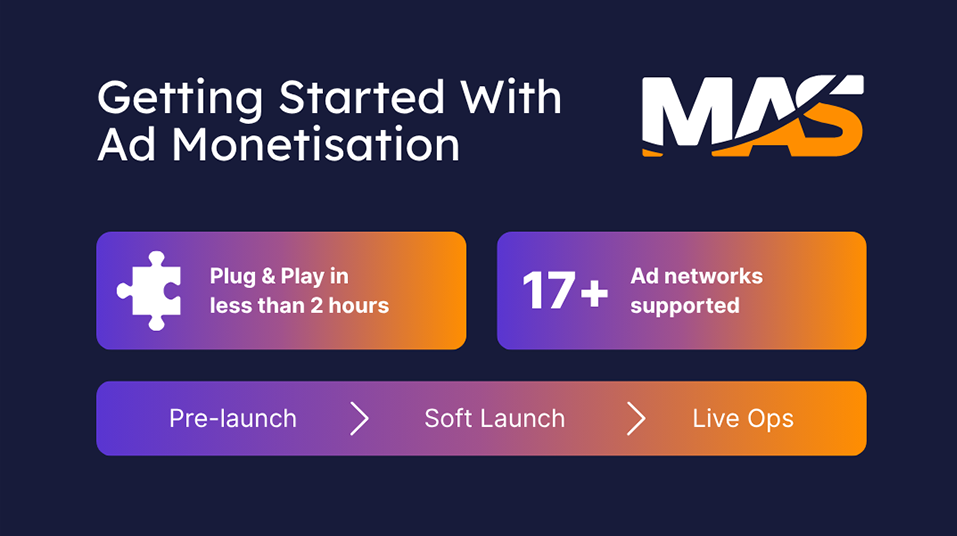
Getting Started With Ad Monetisation
13.10.2025
•
5 mins read
Thinking about trying MAS but still have a few questions? Or maybe you’ve already started using it and need some clarity?
Our Game Growth team collected the most frequently asked questions about MAS to help you make a confident decision and speed up your onboarding.
Integration & Setup
1. What is required before I can monetise with MAS?
There are no special prerequisites — your app doesn’t even need to be live yet. You can integrate MAS at any stage of development.
2. How do I integrate MAS and how long does it take?
Integration is plug-and-play and takes less than 2 hours. You don’t need to connect or configure any ad network accounts — MAS uses its own accounts across 17+ networks.
3. Which platforms does MAS support?
MAS works with Native Android & iOS, Unity, Unreal Engine, Flutter, React Native, Godot, and Cocos Creator.
Ad Formats & Controls
1. Which ad formats are supported?
MAS provides banner ads, rewarded ads, interstitials, app open ads, and native ads.
2. What is capping and pacing, and does MAS support it?
Capping and pacing let you control how often interstitial ads appear, preventing ad fatigue. MAS provides these settings directly in the dashboard to keep users engaged and eCPMs strong.
3. Can MAS block unwanted ads?
Yes. MAS includes an ad blocking feature that filters out unwanted or sensitive ads.
4. Do I need to manage my own ad networks with MAS?
No — Yodo1 can fully manage your ad networks, allowing you to focus on what matters most: developing your game.
Optimisation & Performance
1. How does MAS optimise ads?
MAS continuously improves performance using:
- Industry benchmarks & geo-based targeting
- Ad duration adjustments & tag refreshes
- Regular addition of new networks
This ensures consistently high fill rates and eCPM across regions — lifting your total revenue.
2. What’s the difference between self-serve mediation and automatically managed solutions like MAS?
Self-serve mediation requires constant manual tuning and maintenance. MAS, on the other hand, automatically manages and optimises your ad stack in real time — boosting efficiency and ad revenue while saving you hours of work. Learn more
3. Will MAS increase my ad revenue?
Yes — MAS typically increases ARPDAU by 20–50%, depending on your existing setup.
4. Will MAS increase ANRs (App Not Responding errors)?
No. MAS is built to reduce ANRs, especially on low-end devices, by optimising SDK performance.
App Types & Compliance
1. Can apps (not just games) use MAS?
Yes — MAS works for both games and apps. The only exceptions are:
- VPNs
- Apps from Google Play’s Designed for Families program that target children aged 12 and below.
2. If my game has a mixed audience or requires age-gating, does MAS support that?
Yes. MAS automatically optimises ad delivery for mixed-audience apps using an age-gate system to serve appropriate ads. However, apps fully targeting children under 12 (part of Google’s Designed for Families program) are not supported.
Payments & Support
1. When do I get paid and what’s the payout threshold?
MAS pays in advance on Net-10 terms, with a minimum payout threshold of $100.
2. What kind of support will I get?
Our Game Growth team provides hands-on onboarding, integration, and continuous optimization — offering ongoing support to build long-term monetization success.
Is there a question that’s not on the list? Reach out to our Game Growth team for answers: Contact Us
Or book a free consultation to find out how MAS can help your game grow.
IP Licensing
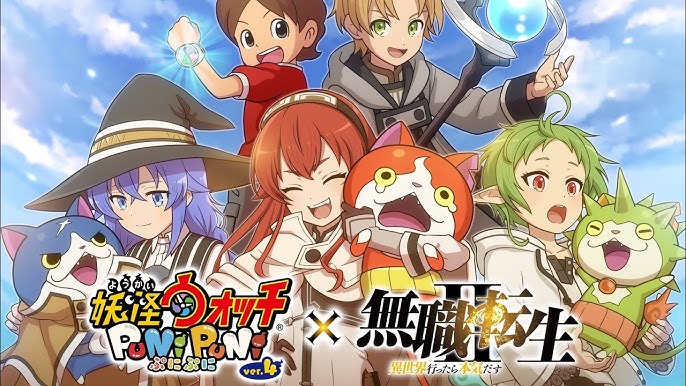
Detective Conan, Demon Slayer; IP Trends You Can’t Miss - August IP Licensing Roundup
05.09.2025
•
5 mins read
Level Up Your Game: August IP Licensing Roundup
Detective Conan, Demon Slayer & IP Trends You Can’t Miss
At Yodo1, we track the latest IP collaborations and market shifts through our DreamData platform to uncover insights that help developers grow smarter. August kicked off with a wave of anime-powered crossovers, bold console launches, and a clear reminder that IP continues to be one of gaming’s strongest growth engines.
Here are the highlights.

Yo-kai Watch: Wibble Wobble x Mushoku Tensei: Jobless Reincarnation
This crossover brings 15 characters, themed stages, hidden challenges, and limited-time mechanics to the Yo-kai Watch universe.
Global | August 1–16, 2025
Yodo1’s Take: This collaboration showcases the continued strength of anime-driven events in Japan and Asia. By offering depth through multiple characters and mechanics, the collab boosts retention while attracting new audiences—a strong example of IPs driving long-term engagement.

Honor of Kings x Detective Conan (Phase 1)
The world’s top MOBA introduces Conan Edogawa and Kaito Kid skins, detective-themed missions, and special rewards.
Global | August 1–31, 2025
Yodo1’s Take: Detective Conan’s global appeal makes this a perfect fit for Honor of Kings. The narrative-driven missions elevate the collab beyond cosmetics, blending storytelling with monetization to strengthen both engagement and revenue.

Tetris 99 x Donkey Kong Bananza
A special Donkey Kong theme is available during the 48th MAXIMUS CUP by earning event points.
Global | August 1–5, 2025
Yodo1’s Take: Nintendo shows how even short, limited-time collabs can drive results. By tying IP to event-based gameplay, they create urgency that reactivates lapsed players and excites existing fans—a simple but effective retention strategy.

Path of Cultivation x Dao of the Bizarre Immortal
This collab introduces character skins, themed rewards, treasure hunts, and new companions like Bai Lingshao.
August 1, 2025
Yodo1’s Take: A great example of “local-first” collaborations. By weaving in fantasy elements that resonate with regional players, the event deepens immersion while adding monetization opportunities, proving that localized IPs can perform just as strongly as global brands.

Isekai: Slow Life x Is It Wrong to Try to Pick Up Girls in a Dungeon?
An original story merges two beloved worlds after a goddess’s mistake.
Japan | August 1–21, 2025
Yodo1’s Take: Japan-exclusive collabs like this highlight the importance of tailoring IP strategies to market. By offering fresh storytelling and exclusivity, the collab creates a strong pull for fans—especially in niche, high-value regions.
Market Insights
- IP collaborations are surging. Crossovers are up, especially on mobile, underlining their value as a user acquisition strategy.
- Anime dominates Asia. Deep anime collabs continue to draw huge fan bases, proving the genre’s staying power in gaming.
- Blockchain experiments continue. More games are testing NFTs and Web3 as business models, though long-term adoption is still unclear.
Yodo1’s Take: The data confirms that IP isn’t just a trend—it’s now a core growth lever for game developers. Anime remains a powerhouse, while blockchain experiments show that studios are still searching for innovative revenue streams. The key is balancing what excites fans with what scales sustainably.
Final Word
From Detective Conan to Demon Slayer, August proved that IP collaborations continue to captivate players and drive growth across genres and markets.
Whether you’re aiming to monetize more effectively, keep your app lean, or launch your own IP collab, Yodo1 is here to help.
👉 Ready to grow with IP?
Game Growth
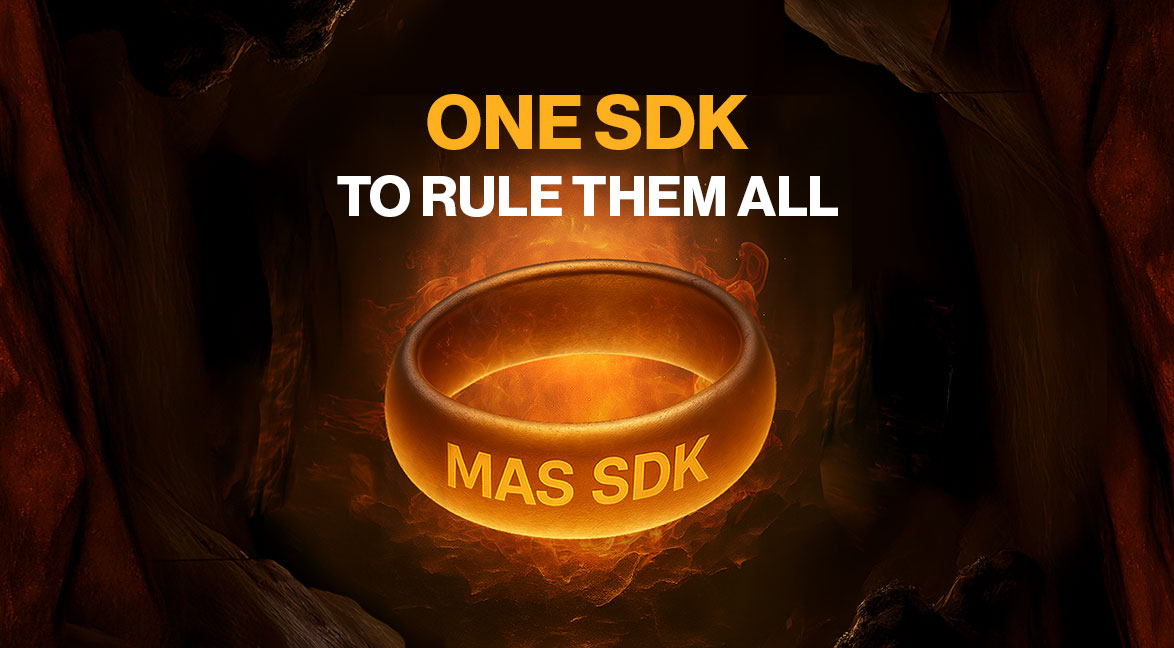
Why Ad Mediation Matters for Indie Devs
03.09.2025
•
5 mins read
Why Ad Mediation Matters for Indie Devs
In the mobile games industry, every click counts, especially when you’re running a lean studio, balancing development with monetisation, marketing, and everything in between. If your game is live and earning through in-app ads, chances are you’ve heard of “ad mediation.” But what exactly is it, and why should indie developers care?
Let’s break it down.
What Is Ad Mediation?
Ad mediation is the tech that connects your game to multiple ad networks—like AdMob, Unity Ads, AppLovin, or IronSource. Instead of relying on a single network to fill your ad placements, a mediation platform acts like a smart traffic controller, choosing the best-paying ad in real time from a pool of partners.
In theory, this setup should maximise your ad revenue. In practice, many indie teams struggle with the complexity of integrating and managing multiple networks effectively.
That’s where Yodo1’s MAS (Managed Ad Services) comes in. MAS simplifies the entire process—handling integration, optimisation, and performance monitoring—so you can focus on building your game while we handle the monetisation.
Why It Matters More Than You Think
If you’re only starting to earn from in-app ads (IAA)—or looking to add IAA to your in-app purchase (IAP) strategy—ad mediation can be a powerful way to boost your revenue. Here’s why it matters:
1. More Networks = Better Yield
Connecting to more ad networks means more competition for your impressions, which usually results in higher eCPMs and more consistent fill rates. With the right mediation stack, many developers see a revenue uplift without making changes to their game content.
2. Smart Monetisation: Beyond Just Bidding
Whether you’re using real-time bidding or a hybrid setup with waterfall, MAS handles the complexity for you. It prioritises networks, sets dynamic floors, fine-tunes formats, and runs A/B tests — all automatically. So you can save time, cut costs, and focus on building your next hit.
3. More Than an SDK: Expert Support On Top
While mediation SDKs simplify integration by centralising ad network management, developers still need to add and maintain individual adapters for each network. These adapters can introduce risks like app crashes, ANRs, and bloated builds — especially without close monitoring. That’s where MAS stands out: Yodo1’s dedicated team handles these technical challenges for you, ensuring stability and providing top-tier support.
4. Time Is Money
You didn’t become a game dev to spend your nights tweaking waterfall logic or emailing support teams. Good mediation should remove that load from your plate so you can focus on building the next big feature, not fixing your ad stack.
But Here’s the Problem…
Mediation can be a headache to manage. Integrating multiple networks, managing requests and payments across different ad networks, dealing with conflicting SDK versions, ensuring store compliance, and maintaining platform stability — these are real challenges, especially if you don’t have a monetization expert on your team.
And that’s exactly why MAS exists.

MAS: Monetisation Without the Stress
At Yodo1, we built MAS (Managed Ad Services) to give indie developers a plug-and-play monetisation engine that just works.
One SDK. 15+ Networks. No headaches managing waterfalls or juggling SDKs.
Up to 50 Percent Revenue Uplift. Real-time bidding ensures better fill rates and eCPMs.
Protection Against Market Fluctuations. MAS leverages ad network diversity to keep your revenue steady — if one CPM drops, another fills the gap.
Quick pay: Payments from all ad networks combined and payment made in advance on net10 basis.
Done-for-You Setup. From integration to optimisation, our team handles it all, minimizing your tech debt.
ANR-Safe by Design. We know how fragile organic growth can be, and MAS is built to protect it.
Whether you’re a solo dev or a small team trying to optimise your first hit, MAS takes the complexity out of monetisation so you can focus on what matters: making great games.
Final Thought: If You’re Not Using Mediation, You’re Leaving Money on the Table
Ad mediation isn’t a “nice to have.” It’s essential instrument for monetising mobile games effectively in today’s market. But you shouldn’t have to become an ad tech expert to benefit from it.
Let us take care of the setup, the networks, the bidding, the optimisation, so you can do what you do best: build, launch, and grow.
Ready to simplify your monetisation?
IP Licensing

How to Tell If Your Studio Is Ready for an IP Collab
03.09.2025
•
5 mins read
Curious about IP collaborations but unsure if the time is right? Here’s how to know when your game and team are ready, and how to set yourself up for success.
Bringing a well-known brand, character, or universe into your game can do more than drive attention. A strong IP collab can unlock new markets, deepen player engagement, and supercharge your monetisation strategy. But IP isn’t a one-size-fits-all solution, and the best results come when your game and studio are set up for success.
So, how do you know if you're ready?
1. Your Game Has Momentum and a Community
Games that perform best in IP partnerships are already delivering value to players. If your title is live and stable, ideally for 6 months or more, and generating consistent revenue, you’ve already cleared a major hurdle. What we typically look for:
- $300K+ in monthly revenue
- A steady or growing user base
- Live ops cadence that supports events or seasonal updates
If you’re seeing solid traction and looking for your next growth lever, IP might be it.
2. You’ve Found the Right IP Before Launch
Still pre-launch but found an IP that could boost your post-launch metrics? We can help integrate the IP before release and schedule its roll-out after launch. In this case, we anticipate:
- Strong IP fit for your title
- A clear roll-out plan in place for the post-launch period
3. You’re Actively Seeking Growth Opportunities
IP works best as a growth multiplier. If you’re exploring ways to attract new audiences, re-engage lapsed users, or increase lifetime value, a well-matched IP can provide the narrative hook or brand recognition to make that happen.
Collabs can take many forms, such as limited-time events, character integrations, crossovers, or co-branded content. They can help you:
- Stand out in crowded UA channels
- Strengthen retention through meaningful content
- Increase monetisation with exclusive items or cosmetics
4. Your Team’s Ready for a Campaign, But Needs Support
You don’t need a 200-person studio to launch a successful IP campaign, but internal alignment is important. Teams that get the most out of IP are those that can dedicate a point person, coordinate across product and marketing, and adapt timelines to fit campaign needs.
Even lean teams can succeed with the right support. We provide flexible onboarding, asset kits, and campaign guidance to make IP as plug-and-play as possible.
5. You’re Creatively Open but Strategic
You know your players better than anyone, and that matters. The best IP partnerships strike a balance between player expectations and brand requirements. Studios that thrive in this space:
- Are open to co-creating with IP holders
- Want to add value to their player experience
- Understand the power of narrative or cultural fit
- Have ideal IPs in mind but lack the right connections to licensors
Whether you’re targeting nostalgia, seasonal appeal, or cross-market expansion, a strategic approach to creative integration makes all the difference.
6. Your Game Matches the Moment
Not every game is right for IP, and that’s okay. A good fit often includes:
- Genres like casual, simulation, RPG, or adventure
- Strong worldbuilding or character-driven gameplay
- Opportunities for skins, events, or crossover mechanics
- A consistent content update rhythm
We’re always happy to assess IP fit with you, and if this title isn’t ready, we’ll help you plan for the next one.
All the boxes ticked? Time for an IP collab!
If this checklist sounds familiar, you’re probably closer to a successful IP collab than you think.
At Yodo1, we’ve helped game studios of all sizes integrate globally recognised IPs in ways that drive real results without overwhelming their teams.
Book a discovery call to explore your options, get honest feedback, and see if an IP collaboration could help you level up your game.
Get Updates From Yodo 1




